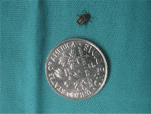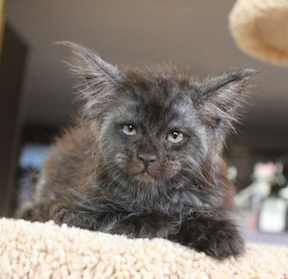These Dog Booties Won't Fall Off!
Lisa Baronoff, Walkee Paws
 Lisa Baronoff lives on the upper west side of Manhattan, is a mom to two dogs and was tired of cleaning her dog's paws after winter walks. She also became worried after her cocker spaniel got sick from the snowmelt chemicals put on sidewalks. But even when there isn't the snow, Lisa just finds the streets so disgustingly dirty. She then took her marketing background and launched her dog waders, Walkee Paws.
Lisa Baronoff lives on the upper west side of Manhattan, is a mom to two dogs and was tired of cleaning her dog's paws after winter walks. She also became worried after her cocker spaniel got sick from the snowmelt chemicals put on sidewalks. But even when there isn't the snow, Lisa just finds the streets so disgustingly dirty. She then took her marketing background and launched her dog waders, Walkee Paws.
After trying all the different booties and shoes out there, Lisa had a problem with them staying on her dogs. They were also very uncomfortable, because they rely on being very tight around the dog's ankle and her dogs hated them and wouldn't wear them. Even if she managed to get them on her dogs, by the time she got downstairs, they would fall off. She knew there had to be a solution.
Lisa has a background in new product development and marketing and she once worked for a pantyhose company in South Africa where she comes from. She then had this brainwave and took a pair of pantyhose, cut them and sort of put them over her dog's back. She then had this idea to suspend a bootie to a legging and attach it over her dog's back. This way, the booties don't rely on staying on by being tight around the dog's ankle and they could actually be suspended over their back. She then came up with a really unique tightening mechanism where you could tighten it so it would fit the dog snugly.
There's been a huge trend towards wearing athleisure in the fashion market in the last two years according to Lisa. She even wears a lot of leggings herself, so she thought it would tie in really well with the humanization trend for dogs to launch leggings that dogs could wear. Why couldn't they wear them too?
It is not surprising to find that Lisa's dogs were the guinea pigs or guinea "dogs" for her new idea. She said her one dog looked really crazy while he was wearing black pantyhose.
While dogs might not love them, they do get used to them very quickly. When Lisa first put them on her dogs, amazingly after walking funny for the first few minutes and feeling a little strange, they got totally used to them. In fact, when she was testing them, her dogs would lie around all day in them until she felt that they should take them off. She thought they would try and get them off, but they never tried. However, when you initially put them on some dogs, because it's a strange sensation, they will do a little bit of a funny walk. But this lasts literally a minute or so and they get used to them and forget they're wearing them.
 There will always be some dogs who start walking immediately after having them put on and there will always be dogs who just stand there not knowing what to do for a few seconds. Lisa tells people after putting them on their dog, they just need to leash them up and get them going. The minute the dogs start walking and they can feel the ground, they're totally fine.
There will always be some dogs who start walking immediately after having them put on and there will always be dogs who just stand there not knowing what to do for a few seconds. Lisa tells people after putting them on their dog, they just need to leash them up and get them going. The minute the dogs start walking and they can feel the ground, they're totally fine.
When they are on a dog, the Walkee Paws actually look like really hip fishing boots for dogs, or waders, because they look like suspenders with rubber feet. But when they are on, is a dog able to do its business? Lisa says that's not a problem. Because they are completely open in that area, there's never an incident of them becoming soiled. In fact, it actually helps, as her older dog has a habit of doing his business and then stepping in it. Now, when he steps in it with the rubber booties, she can leave them outside her door and leave the mess outside.
Walkee Paws actually started off just with three sizes; small, medium and large. So they cater to about 80-percent of the dogs. They don't cater to the tiny teacups at this point. As well as three different sizes, Walkee Paws also come in three different patterns. They have cocoa, which is a plain brown for the person who doesn't really want to make a big statement. They also have a pattern called confetti, which has a black background with little dots in bright colors. This one is more for the girl dogs and for those who want to make a splash and really make a fashion statement. And for those who really want to be fashion forward, they have the camouflage, which is very, very fashionable.
Look for new patterns of Walkee Paws every couple of months. They are already looking at new patterns and tying them in with the holidays. Unfortunately they were a little late for Valentine's Day, but they have something really special for July fourth, for Halloween and for next year's Valentine's Day.
But that's not all, they are investigating doing a doggy and me line, which would be doggy leggings that would match the owner's legging.
The pricing for the Walkee Paws is variable, which is common in the pet industry, because the amount of fabric they use on the side small is far less than they use on the size large. Pricing starts at $19.99 for the small, the medium is $24.99 and the large is $29.99. They are available on their website, WalkeePaws.com and they just got back on to Amazon after selling out in October because of the high demand.
Walkee Paws seems to have hit a chord with people, says Lisa, and they're getting some really good reviews on them. People are saying thank you for finally introducing something that the dogs feel comfortable wearing. And the fact that they don't fall off is a big plus for people. People talked about losing a lot of booties in the winter, which Lisa has seen plenty of stray booties that have come off dogs around New York. However, you'll never lose another booty with Walkee Paws.
Before inventing Walkee Paws and besides working for a hosiery company in South Africa, when she came to the states Lisa worked for Mattel for Fisher Price Toys. The last thing that I was involved in before she left was the Tickle Me Elmo re-launch.
Visit Website
Weather Predicting Pig!
Dr. Pages Wages, Care First Animal Hospital
 Dr. Page Wages is a Raleigh veterinarian who loves animals so much; she has 93 on her "Funny Farm" and a Weather Predicting Pig. Elmer the Pig has some weird behavior when it's going to rain. Dr. Wages describes her big family and what she has to do every day to care for 93 animals. Growing up, she was only allowed to have a dog and a cat and she's made up for it.
Dr. Page Wages is a Raleigh veterinarian who loves animals so much; she has 93 on her "Funny Farm" and a Weather Predicting Pig. Elmer the Pig has some weird behavior when it's going to rain. Dr. Wages describes her big family and what she has to do every day to care for 93 animals. Growing up, she was only allowed to have a dog and a cat and she's made up for it.
On her "Funny Farm" in her backyard, Dr. Wages tells us she has a little mixture of everything. She has two pigs, eight dogs, two rabbits in the house and three outside, two cats, three goats and then all the rest are chickens, ducks and peacocks.
It takes Dr. Wages about one and one half hours every morning and every evening to feed her menagerie. Even with her full time practice. Dr. Wages said it was easy to make time to do this and that it's actually fun. She just has to get up really early and stay up really late. And of course there is the cost, but that is just a part of being a pet owner.
Surprisingly, people have never told her she was crazy to have so many animals. In fact, people come out to her "Funny Farm" to pet the animals and everybody loves it.
Most of Dr. Wages' animals have special needs of some way, shape or form, which a lot of people think is kind of neat. Dr. Debbie says that is a running joke in the vet world, because it seems that vets don't ever have animals with all their body parts. They're usually missing something!
Dr. Wages has a chicken with no legs and another chicken with a prosthetic leg. Chicken Little, the chicken with no legs, was brought to her by Animal Control. He was so tiny; no one felt he would live. However, Chicken Little is four now, but he never grew any legs. So when it rains a lot, he can't get off the ground and has to come inside, or if it's too cold outside he comes inside. Even though he is on the ground, he plops around and has a girlfriend. He also has a small house so they can go in and out and he does just fine. Chicken Little's other girlfriend just died from old age and so Dr. Wages had to find a new girlfriend for him because he got really lonely, as the other chicken picked on him.
As well as all her chickens, Dr. Wages has a weather predicting pig. Dr. Wages has two pigs, a male and female both neutered and spayed. One day the male, Elmer, started carrying sticks and making a pile by the door when he was outside. Dr. Wages looked this up in the Farmer's Almanac, which stated that pigs will start carrying sticks around if it's going to be a cold winter. And they did have a horrible winter last year. Elmer has started doing it again this year. He does it about a week or two before they have a really bad cold snap or a really bad snowstorm, which is odd for North Carolina anyway. Elmer is now her weather predicting pig and has basically been correct every time so far. However, now her back porch is full of giant piles of sticks.
So what does the weather look like for the next week or so in North Carolina? Dr. Wages says according to Elmer, it's actually going to be a little bit chilly because there was a pile of sticks when she got home two days ago. So she thinks they are headed for another cold snap.
Dr. Wages is very involved in community service and spends seven months out of the year training students and others interested in missions. She leads four mission trips annually, working with the Native Americans and Christian Veterinary Mission. Her mission work involves working with the Cherokee in NC, Yup'ik in Alaska villages and the Navajo.
ABC 11 from North Carolina did a story on him on predicting the weather recently, and you can view the video here.
Ticks Hitchhike on City Dogs Too - Dr. Debbie
 Ticks are common parasites known to infect people, pets and spread disease. Over 850 tick species exist worldwide, although fewer than a dozen species are of risk to pets in the U.S. But here in Las Vegas, pet owners often dismiss the existence of ticks with the likes of Bigfoot or the Loch Ness Monster. Think ticks are only a problem for pets that travel or visit the mountains? Think again.
Ticks are common parasites known to infect people, pets and spread disease. Over 850 tick species exist worldwide, although fewer than a dozen species are of risk to pets in the U.S. But here in Las Vegas, pet owners often dismiss the existence of ticks with the likes of Bigfoot or the Loch Ness Monster. Think ticks are only a problem for pets that travel or visit the mountains? Think again.
The Tick Tale
Ticks are parasites known to infect mammals, reptiles and birds and feed on their host's blood. Although of tiny size, ticks ingest 200 to 600 times their weight in a blood meal.
Ticks are attracted to a host's movement, body warmth or exhaled carbon dioxide and then latch on. Through this feeding behavior they can transmit diseases to pets such as Lyme disease, Rocky Mountain spotted fever, Ehrlichia, Babesia and Tularemia. Disease transmission takes some time and may occur after 36 to 48 hours of feeding behavior.
Some ticks can live months or up to a year off its host without a feeding, so year-round prevention is important for pets at risk for continued exposure.
Battling Ticks
There are many topical tick control products available for pets. Speak with your veterinarian for an product that is effective and safe with your pet's individual health in mind. Cats are sensitive to some ingredients, may develop toxicity, and should never be treated with a product labeled only for dogs. Additionally, pet owners using multiple products on their pet should first consult with their veterinarian to ensure safe use of combined products.
In addition to topical tick control, environmental treatment with foggers, sprays or pest control service should be considered for heavy infestations. Limit tick habitat zones by maintaining landscaping, avoiding overgrown grass and keeping shrubs and plants trimmed.
Pet Screening
Perform daily tick checks during tick season. Examine your pet for ticks in areas that the parasites hang out - around the head, behind ears, armpits and between toes.
 When removing a tick, avoid handling it directly. Wear gloves or handle with Kleenex since ticks can pass infections to people as well. Grasp the tick with tweezers close to the skin. Extract the tick by pulling straight out of skin. Don't squeeze, twist or leave any legs behind. Disinfect the area and dispose of ticks in rubbing alcohol.
When removing a tick, avoid handling it directly. Wear gloves or handle with Kleenex since ticks can pass infections to people as well. Grasp the tick with tweezers close to the skin. Extract the tick by pulling straight out of skin. Don't squeeze, twist or leave any legs behind. Disinfect the area and dispose of ticks in rubbing alcohol.
Here's a photo of a typical tick, born and bred in Las Vegas and recently extracted from one of my Shih Tzu patients named Kane. Kane never leaves the state, doesn't hike in the mountains, and enjoys the comforts of a house-dog lifestyle. A tick was discovered on Kane after a day of supervising his owner's yard work and shrub trimming.
Maybe Kane's story will be an eye-opener for city dwelling pet owners. Pet parasites like fleas, ticks and mosquitoes still lurk in that urban jungle.
Visit the Dogs & Ticks website for more information ticks, diseases and prevention.
Featured veterinarian known as "Dr. Debbie" on national pet radio program, Animal Radio. Ebook author of "Yorkshire Terriers: How to Be Your Dog's Best Friend"; "Pugs: How to Be Your Dog's Best Friend"; "Mini Schnauzers: How to Be Your Dog's Best Friend"; and "Shih Tzu: How to Be Your Dog's Best Friend." Dr. Debbie's books.
Visit Website
Animal Radio News - Lori Brooks
 Mice Talk
Mice Talk
Rodents spend all day talking to each other, but what are they really saying? We can't hear many of their vocalizations because they're so high pitched. But now, two young scientists at the University of Washington School of Medicine have developed a software program called DeepSqueak, which takes mice communications and transforms them into an image or sonogram. One of the inventors investigates complex behaviors relating to stress and addiction, while the other inventor's specialty is studying the psychological aspects of drugs. Their new program will allow them to study the effects of medications and the side effects of addictive drugs and medications that can help addicts. Interesting side notes from their research so far: mice have about 20 different calls or types of communication; the mice are happiest when they're playing or getting sugar; and when male mice get together, they tend to repeat the same calls over and over and over. However, when they sense a female mouse nearby, their vocalizations are more complex, as if they are singing a courtship song.
 Regulation Needed on Keeping Exotic Animals in Private Facilities
Regulation Needed on Keeping Exotic Animals in Private Facilities
A lion killed a young female intern at a North Carolina wildlife center late last year when the lion got loose while she was cleaning his enclosure. That tragic accident has put a new focus on how keeping exotic animals in private facilities is regulated by the state. It turns out that North Carolina is one of just four states in the nation with very few or no laws for keeping wild animals like lions, bears and primates in captivity. The three other states that have little or no regulations on the ownership of exotic animals are Alabama, Wisconsin and Nevada.
Russia Puts New Animal Laws Into Place
Russian President Vladimir Putin has signed new animal welfare laws. The laws include banning petting zoos and animal fights. It also bans the killing of stray animals, which must instead be captured and placed in shelters. It also states that only domestic animals can be kept as pets at home with no exotic pets allowed. Dog owners in Russia must now also walk their pets only in specially designated places and clean up their waste. And, dogs of potentially dangerous breeds when walked in public must be on a leash and wearing a muzzle. Also, when those stray animals are captured and taken to a shelter, they can only be captured out of sight of children and it must be recorded for public review. This was not a fast change. The laws were first submitted to the Russian parliament in 2010 but were only approved and signed into law last month.
 Cats Rule The Internet
Cats Rule The Internet
The 2018 favorite cats online list is out. The list includes Bongo, a cat who started out as a gif; Doughnut from Florida, who is on a diet after being adopted at three times what his healthy weight should be; Tigger the lap cat, who must sit on his human dad's lap for at least 30 minutes each day before dad goes to work; Theo, the cat who saved his owner's life by keeping her awake when she had a blood clot (sadly, Theo passed away just one week before he was awarded the National Cat of the Year title); Valkyrie, the Maine Coon cat that has a human face; and of course the adorable cat on Instagram named Baloo who brings its owner a leaf every morning also made the list of favorite Internet Cats of 2018.
Having A Pet Can Make You a Successful Leader
We all know that vision, forward thinking, risk-taking, determination, hard work, dedication and a good game plan are what it takes to become a successful entrepreneur. However, something else isn't so well known also helps. According to a new study (which was conducted for Banfield Pet Hospitals), having a pet, it doesn't matter what kind or breed, can actually help people become successful and better company leaders. The research found that behind most C-suite executives (which are the CEO's, CFO's, COO's), is a pet. In a survey of 857 people with the word Chief in their title, 93-percent said that their childhood was filled with pets. Eighty-three percent of them grew up with a dog; 59-percent grew up with a cat and 37-percent grew up with pets like birds, rabbits or rodents. But regardless of what kind of animal or pet, the leaders agreed their childhood companions taught them valuable lessons such as responsibility, empathy and creativity and these qualities have supported them in their ability to thrive as leaders in the workplace.
Coyote Mating Season
You may notice more coyotes in your neighborhood because mid-January to mid-March is coyote mating season, which brings on more movement and activity as they search for a mate. So how do you keep your pets safe? Experts in wildlife say wave your arms in big circles and yell at them or perhaps throw a stick or some stones, not to hit the animal, but near it, to give the coyote a healthy fear of humans. You should know that coyotes see dogs as a competitor in their territory, so keep your dog close to you whenever you are walking them outside, especially at night. One expert suggests taking something with you on walks to scare coyotes away. Consider putting some coins in a soda can to shake and make loud noise. Another tip is to keep your yard clean so you avoid attracting coyotes. If your birdseed is getting scattered all over the place, that can attract other animals like squirrels or rats, which are prey species for the coyotes. If you see a coyote that looks injured or needs help, you should leave it alone and contact the Wildlife Rehabilitation Center in your area.
 Listen to the entire Podcast of this show (#999)
Listen to the entire Podcast of this show (#999)





